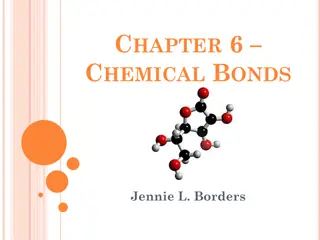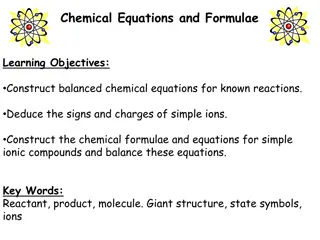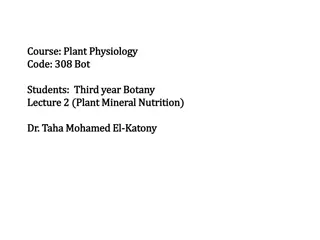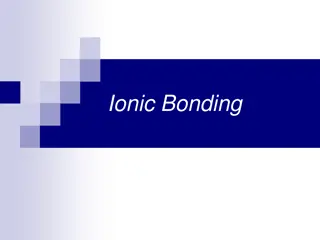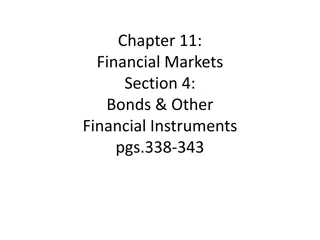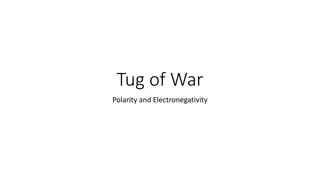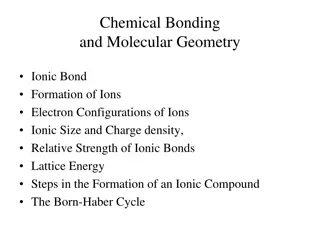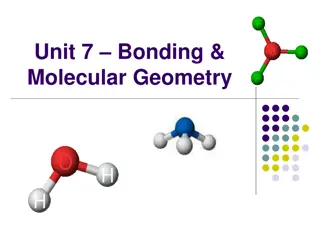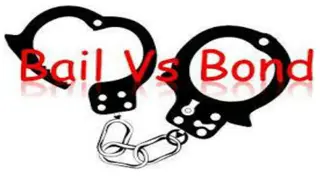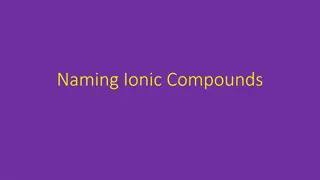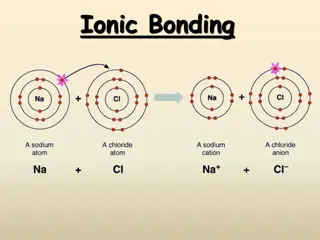Understanding Ions, Ionic Bonds, and Ionic Compounds
Ions are charged particles formed by gaining or losing electrons, leading to the formation of ionic bonds between positively charged cations and negatively charged anions. The octet rule guides electron configurations, and the periodic table helps predict ion formation. Ionic bonding involves electrostatic attraction, with metals losing electrons to nonmetals. Naming conventions and properties of ionic compounds are explored in this study sheet.
Download Presentation

Please find below an Image/Link to download the presentation.
The content on the website is provided AS IS for your information and personal use only. It may not be sold, licensed, or shared on other websites without obtaining consent from the author. Download presentation by click this link. If you encounter any issues during the download, it is possible that the publisher has removed the file from their server.
E N D
Presentation Transcript
Ions, ionic bonds and ionic compounds Study Sheet #2
Learning Objectives: Define ions, ionic bonds, and ionic compounds. Explain how ionic bonds form. Describe the properties of ionic compounds. Identify and name common ionic compounds. Key words: Ions Cations Anions Octet Rule Ionic bonds Ionic compounds
What are ions? Ions are electrically charged particles formed when atoms gain or lose electrons. These charges can be positive or negative. Cations (positive ions): Atoms lose one or more electrons to become positively charged. Metals often form cations as they have fewer electrons in the outermost energy level and readily give them away. Anions (negative ions): Atoms gain one or more electrons to become negatively charged. Nonmetals often form anions as they attract additional electrons.
Octet rule: atoms tend to have a stable electron configuration, similar to noble gases, which typically have 8 electrons in their outermost energy level (except for elements in period#1 / Hydrogen and Helium). Atoms gain or lose electrons to reach this stable configuration. Formation of sodium ion: The sodium ion has 8 electrons in its outer shell. Its outer shell is full, so the ion is stable. Formation of chloride ion: The chloride ion has 8 electrons in its outer shell. Its outer shell is full, so the ion is stable.
You can use the periodic table to predict whether an atom will form an anion or a cation, and you can often predict the charge of the resulting ion. The name of a metal ion is the same as the name of the metal atom from which it forms, so Ca2+is called a calcium ion. When naming a non-metal ion , the suffix ide is added to the root name of the element. O-2is called an oxide ion.
3 4 1 7 2 5 6 8
What is ionic bonding? What is ionic bonding? Ionic bonding is the electrostatic attraction between positive and negative ions. In ionic bonds, the metal loses electrons to become a positively charged cation, whereas the nonmetal accepts those electrons to become a negatively charged anion. Ionic bonds require an electron donor, often a metal, and an electron acceptor, a nonmetal. In sodium chloride, ionic bonds hold the ions together in a giant structure.
Examples of formation for 2 ionic compounds: 3Li: 2,1 12 Mg: 2,8,2 9F: 2,7 8O: 2,6 3Li+1: 2 12 Mg+2: 2,8 8O-2: 2,8 Attraction forces between the positive and negative ions formed is called Ionic Bonding. 9F-1: 2,8
Chemical Formulae for Ionic Compounds: Chemical Formulae for Ionic Compounds: 1- Write the symbol and charge of the metal first and the non-metal second. 2- Transpose only the number of the positive charge to become the subscript of the non-metal , and the number of the negative charge to become the subscript of the metal. Examples of molecular formula for ionic compounds with single atomic ions: Most compounds made up of a metal and a non-metal are ionic.
Naming Ionic Compounds: Naming Ionic Compounds: Always name the cation before the anion; in the chemical formula, the cation will always appear first as well. When naming the cation within an ionic compound, we don't include the word ion or the charge .We only have to name the element that the ion came from . When naming the anion within an ionic compound, the suffix ide is added to the root name of the element.
Ionic bonding and physical properties Ionic bonding and physical properties Ionic compounds have high melting points. This is because the electrostatic attraction between oppositely charged ions is strong. Ionic compounds are brittle, If you drop a crystal of an ionic compound, it breaks between one row of ions and another. The broken pieces have straight ridges.


